Some people say the Joshua Trees, for which Joshua Tree National Park is named, were the inspiration for the Truffula trees in ‘The Lorax’ by Dr Seuss.
But those trees! Those trees! Those Truffula Trees!
All my life I’d been searching for trees such as these.
The touch of their tufts was much softer than silk.
And they had the sweet smell of fresh butterfly milk.
I felt a great leaping of joy in my heart.
I knew just what I’d do! I unloaded my cart…
I can relate to that sensation – of joy leaping up in my heart – as I start to explore Joshua Tree National Park out here in the Californian desert.
Although neither soft like silk nor sweet like butterfly milk, the trees nonetheless bring awe to all who see them for the first time.
If you know the plot of the book, you’ll know that all the Truffula trees were chopped down to make material goods that were sold to humans.
Thankfully the Joshua Trees did not befall the same fate. And it was thanks in a large part to the activism of a woman called Minerva Hoyt in the early part of the 20th century that this unique park has been protected since 1936.
A large part of Joshua Tree National Park is off limits to visitors, allowing nature to continue unhounded. But the more developed areas offer a large variety of things to see and do.
As a hiker, I am pleased with the selection of tracks within the park.
Longer ones allow me to explore the landscapes for hours while shorter ones mean I can string a few different places together in an afternoon to get diversity.
But, unlike some other national parks, you don’t need to hike to see the highlights – there are plenty of ways to spend two days in Joshua Tree and never go far from the road.
How many days should I spend in Joshua Tree?
I think two full days is a good length to spend in Joshua Tree National Park. Any less and you won’t be able to see the main attractions. With three days, you likely won’t see much more, but you’ll be able to be a bit more leisurely.
When is the best time to go to Joshua Tree?
Out in the desert, summers can be blazingly hot in the day, while winters feel freezing in the evening. That’s why the best time of year to visit Joshua Tree is outside of these extremes, either in spring or in autumn – although holiday periods get very busy.
Why is Joshua Tree National Park special?
Two deserts meet at Joshua Tree National Park, creating a unique ecosystem for the fascinating flora and fauna you’ll find here – particularly the iconic Joshua Tree itself. With landscapes sculpted by wind, piles of enormous boulders, and valleys of palm trees, there’s lots to see at Joshua Tree National Park.
The Joshua Trees often stand tall, isolated, perhaps silhouetted by the sun. Sometimes they group together forming a forest over a plain.
Enormous jumbles of boulders rise up from the flat dry land in places or a mountain range seems to form a natural boundary in the distance.
In the southern part of the park, where the Mojave Desert becomes the Colorado Desert, the Joshua Trees don’t grow and are replaced with dramatic palms.
I was a bit daunted at first when I looked at the map and the possibilities of activities at Joshua Tree National Park. It wasn’t clear where to start or what the best way was to put together a plan.
One way to get around that is with a guided tour – and there are some good ones, including this off-road tour, or this half-day hiking tour.
You can see some more options here:
After spending a few days exploring the park independently, and seeing it all for myself, it now makes much more sense, and I think it’s easy enough to plan a visit yourself.
And so I want to share with you a two-day itinerary for Joshua Tree that will take you to the best hikes and also show you the rest of the highlights.
If you would like to see where everything I’m going to suggest fits within the park, I have put together this map.
And it’s worth saying this: Although this is a two-day Joshua Tree itinerary, you could use it to plan just a single long day in the park, or even a more leisurely three days in the park.
After all, I’ve got some accommodation suggestions further down, but I appreciate you may be trying to fit in a drive from Los Angeles or elsewhere.
If you need a rental car, I recommend using Discover Cars in the US for the best deals. But if you’ve got your wheels, let’s get moving!
Day 1
I’m assuming that you will spend the morning leisurely driving from somewhere like Los Angeles (maybe stopping in Palm Springs) and will arrive late morning.
For this itinerary, I recommend you enter through the southern entrance off the I-10.
You should first stop at the Cottonwood Spring Visitor Centre to pay your registration fee ($30 per vehicle for a week). You should also pick up a map and some other brochures with information about the park.
If you’re going to be visiting multiple national parks, the annual America the Beautiful pass is a great deal for just $80!
Take note that there are no food facilities or shops in the national park. You’ll need to take lunch in with you and I would highly recommend having a few large water bottles in the car (enough to get you through a day of hiking).
Lost Palms Oasis
The first hike I would recommend is the Lost Palms Oasis and it starts just around the corner from the Cottonwood Spring Visitor Centre.
It is one of the longer ones in the national park and isn’t in the main tourist area. This is one of the things I love about it because it’s not as full of people.
It is about 6 kilometres (3.5 miles) in each direction and should take about 3 hours for a fast hiker.
The track takes you through some wonderful landscapes of orange rocky hills and green cacti. The coarse desert is interrupted constantly by shrubs and trees of yellow flowers.
This part of the park is in the Colorado Desert where the Joshua trees don’t grow. The highlight is the fan-palms which rise up in certain places where there’s enough water.
This hike takes you to a canyon full of the palms. After a hot long walk, this oasis is refreshingly cool and a wonderful place to have a rest.
Be warned that you’ll need to take enough water with you for the whole hike and it can get very hot in the summer months. Wear sunscreen and take some provisions for emergencies.
Cholla Cactus Garden
From the Lost Palms Oasis, drive north to the Cholla Cactus Garden. There isn’t really a hike here, as such, but there’s a lovely nature trail that takes you amongst the dense collection of cacti here.
It’s a really photogenic place so bring your camera with you for this one. You can spend as long or as little as you want here – I would recommend about 30 minutes.
Driving further north, you’re now getting into the part of the park that has most of the sights and is more popular with tourists.
You have a couple of choices for how to spend the rest of day one of this itinerary, depending on time (and daylight):
- You can leave through the north entrance and go to your accommodation at Twentynine Palms.
- You can leave through the north entrance and visit the Noah Purifoy Desert Art Museum at Joshua Tree. (Because of the location, it makes more sense to do this tomorrow afternoon but you might be short of time if you’re driving back to LA.)
- You can do a bit more exploring at Skull Rock and Jumbo Rocks.
Skull Rock and Jumbo Rocks
Skull Rock got its name for fairly obvious reasons – it looks like an enormous skull.
You can see it from the road but it’s best to stop the car and get out to see it properly.
There is a small hiking trail here that takes you around the rest of the rock formations but doesn’t take long – it’s more about getting some different viewpoints.
Drive just a little further up the road and you’ll come to Jumbo Rocks. The campground is on the left and it looks like a great place to spend the night if you’re equipped for that.
For some exploring, though, I would recommend the rocks on the other side of the road. The enormous smooth boulders are easy to climb and give you fantastic views across this part of the park.
You can follow the makeshift trail or create your own route to walk around and see the Joshua trees.
From here, I would suggest driving back out to the north entrance because you’ll be exploring the rest of the park tomorrow.
There are plenty of great spots along the road to stop and get some beautiful sunset photos if it’s approaching that time of the day.
Tonight, the most convenient place to stay is at Twentynine Palms, where there’s a good range of accommodation options.
THE BEST ACCOMMODATION IN TWENTYNINE PALMS
There are some beautiful holiday homes here, but if that’s more than you need for just one night, there are also plenty of motels to choose from.
BUDGET
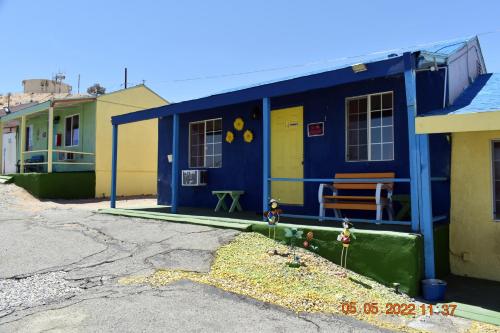
Although it’s certainly seen better days, you likely won’t find anything cheaper than 9 Palms Inn.
MID-RANGE

Of all the motels, I think the Holiday Inn Express is the nicest – and even has a lovely pool to refresh in.
HOUSE
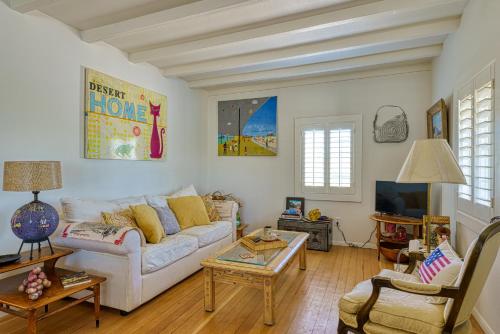
If you’re travelling in a group, Cactus Adobe offers a charming house really close to the national park’s entrance.
YURT!
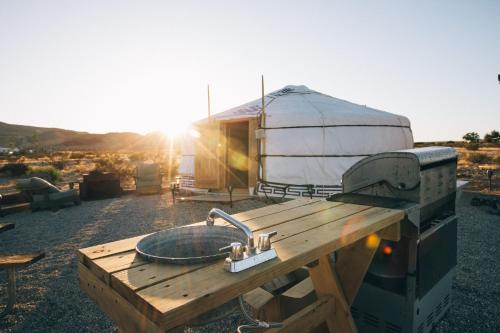
Why not make a great trip even more special with this stargazing yurt at 28 Palms Ranch.
Day 2
To start the second day of exploring Joshua Tree National Park, drive back in through the north entrance.
Hall of Horrors
The first stop I would recommend is the Hall of Horrors, a beautiful spot where Joshua trees fill the foreground in front of a large pile of boulders that look like a hill.
It’s an easy place to park the car and take some photos. There is a track that goes around the hill and takes about 20 minutes to walk.
This is a popular place for climbers and it’s likely you’ll see some people going up on the other side, as you walk around.
Ryan Mountain
Just a short drive from the Hall of Horrors is Ryan Mountain. There is a hike here that goes up an elevation of about 330 metres (1100 feet) to get you to a total height of 1664 metres (5461 feet).
It’s not a particularly long trail but, because of the incline, will take you about 2 hours to go the round trip of 2.4km (1.5 miles) each way.
From the top, you get great views out across Lost Horse and Pleasant Valleys. I don’t think this is the best scenery along the way, though, so if you’re going to be short of time today, this is probably the one to skip.
Lost Horse Mine
The next stop I would recommend is the Lost Horse Mine hiking trail which has some great diversity on the one walk.
It is a circular trail of about 6.4km (4 miles) that has a fair amount of uphill (and downhill) along the way. It will take about 2 hours for a fast hiker.
The best way to go is clockwise, beginning with a long uphill stretch until you reach an old mining site called Lost Horse Mine.
There are some nice views along this stretch but the highlight of the first bit is the mine itself, which you can get close to and see the rusty ruins.
From here, the trail takes you along the crests of the mountain range, with spectacular vantage points across the desert and some different plant species that only grow at the slightly higher elevation.
After you come down from the mountains, the last stretch of the hike is one of my favourite bits as you go along a sandy valley filled with Joshua trees.
Most of them are much larger than the other ones you’ll see in the park (presumably because there’s more water in this area) and so it’s quite impressive to walk amongst them, especially when they are silhouetted against the sky and the sun.
The trail is long enough that you should take a fair amount of water with you and have appropriate sun protection in the hotter months.
Hidden Valley
Driving north from Lost Horse Mine, you’ll get to Hidden Valley. This is one of the most popular parts of the park because of the beautiful scenery and easy accessibility.
The rocks form a natural protective area and it’s said that it was once used by cattle rustlers because they were able to keep the animals contained fairly easily.
There aren’t really any official hiking trails here but there are plenty of opportunities to go for a walk around the area and get different viewpoints of the trees and the rocks.
For most people, though, this can be a fairly quick stop unless you want to stop here to have lunch. There are picnic tables and some other basic facilities that make it a good place for a rest.
Barker Dam
The last stop I would recommend for today is Barker Dam, which has two hikes you can link together. They’re both a bit different so try to do both, if possible.
Both trails start next to each other at the car park so take a good look at the signs to see which direction to go.
Begin with the walk to the Wall Street Mill which is 3.2km (2 miles) there and back. It should only take about 40 minutes for a fast hiker.
Along the way you’ll see some of the remnants of the gold mining history of Joshua Tree National Park. The tall windmill shouldn’t be hard to miss. The rusty metal is beautiful in a way that seems to blend in with the nature around it.
You’ll then make it to the small mine, which is fenced off to stop people going inside for safety reasons. Make sure you see the old car that is sitting in the sand just off to the side of the mine – it looks like a character right out of an animated movie!
Once you’re back near the carpark, you’ll be able to join the trail out to Barker Dam. This is a 1.8km (1.1 miles) loop trail that first takes you out to the dam that early cattle ranchers built.
Sometimes it can be dry but, if there’s water in it, it’s a rather unusual sight out here in the desert!
After you’ve cut down along the side of the dam, you’ll find yourself in a large plain. The track takes you back around the carpark but a fun thing to do is go straight ahead to the large rocky mountain in front.
You can scramble up the rocks here and go for a bit of an exploration at the top, then cut down the other side. It’s safe enough but you’ll obviously need a decent level of fitness.
And that takes you to the end of the second day. From Barker Dam, you can head out through the west entrance, which takes you to the town of Joshua Tree.
Noah Purifoy Desert Art Museum
If there’s still sunlight and you have time, I would highly recommend stopping in Joshua Tree and going to the Noah Purifoy Desert Art Museum.
It’s a collection of outdoor art that was made out of recycled materials by Californian artist, Noah Purifoy.
It’s free and you can just walk in and explore on your own. The art is fascinating and the whole atmosphere it creates is quite unique.
From here, you should still have time to drive back to Los Angeles or Palm Springs this evening. But, if you prefer to stay the night in Joshua Tree after a big day of hiking, there are a couple of decent options.
THE BEST ACCOMMODATION IN JOSHUA TREE
There are fewer places to stay in Joshua Tree than Twentynine Palms, but there’s still plenty of variety from motels to holiday houses.
MOTEL

With comfortable rooms at a reasonable rate, High Desert Motel is the best value in Joshua Tree.
VILLA

The cozy accommodation at Center Street Villas gives you a bit more space right in the heart of town.
HOUSE
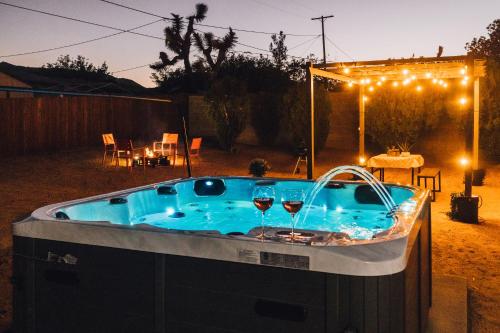
If you’re travelling in a group, the three bedrooms at this holiday home are all pretty cool.
LUXURY
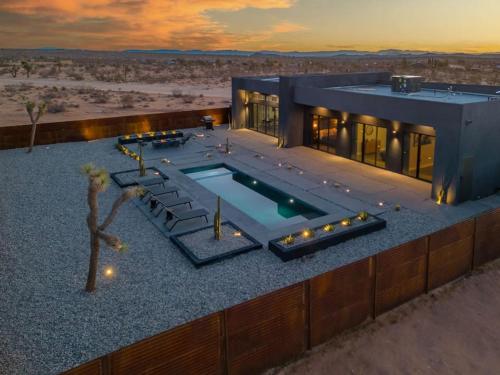
And for a more luxurious home, the modern Black Sky House has an incredible design and private pool.
And that’s a very quick couple of days in Joshua Tree National Park! If you’re looking for a longer break, you might like to rent one of the holiday homes and stay a few nights, relaxing by the fire in the evening.
Otherwise, I think you’ll see all the most important things by the time you finish this two-day Joshua tree itinerary.
Please let me know below if you have any other suggestions.
Nice pictures of a beautiful place!
Just found your Joshua Tree Guide on Pinterest. This is one of the best I’ve read. I am heading over in January with my teenage son, and I can’t wait to explore!! Thanks for all of your tips!
The Truffula trees are loosely based on the the lone spruce tree in La Jolla, California. Dr Seuss used to live in La Jolla.
https://www.lajolla.com/article/dr-seuss-la-jolla/
Hi Michael
Your photos are inspirational, really beautiful, I live in the UK we don’t see scenes like this. I am an artist looking for reference material for my paintings, would it be possible to use some of your images as reference for a painting?
I am leaning towards abstract painting, or, ‘Abstract Vector Impressionism’ to be more precise, after many years of painting in the traditional way, you can see examples of my artwork on my website
I look forward to seeing more of your photos
Best regards
Bob Hughes
Thank you for sharing this guide. I am headed to Joshua Tree in January and can’t wait to see some of the spots you talked about.